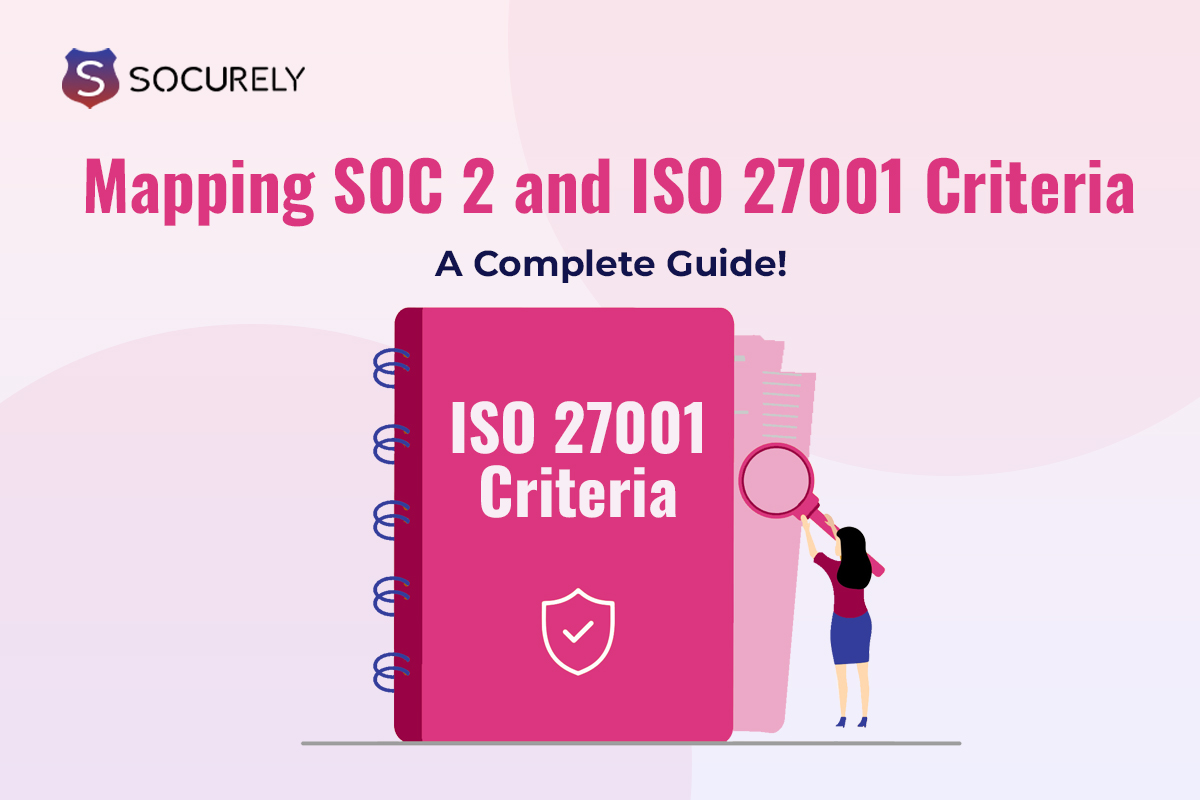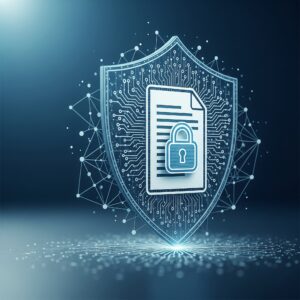Getting robust data security and compliance has become paramount for organizations globally, especially in today’s cyber crime-prone world. According to a recent study, 68% of business leaders feel their cybersecurity risks are increasing. Among the myriad frameworks available, SOC 2 and ISO 27001 stand out as gold standards in compliance. SOC 2 is predominantly favored in the United States, particularly among service organizations, while ISO 27001 enjoys widespread global acceptance. Together, these frameworks offer a comprehensive approach to information security, helping businesses protect sensitive data and build trust with their clients.
Although, both compliance frameworks SOC 2 & ISO 27001 provide comprehensive guidelines for managing and protecting sensitive data. However, understanding how they align can be challenging. This guide will explore the similarities and differences between SOC 2 and ISO 27001 Compliance mapping and provide a detailed mapping of their criteria.
SOC 2 Vs ISO 27001
SOC 2:
- Developed by the American Institute of CPAs (AICPA), SOC 2 focuses on service providers storing customer data in the cloud.
- It centers around five Trust Service Criteria (TSC): Security, Availability, Processing Integrity, Confidentiality, and Privacy.
- Primarily used by organizations to demonstrate their commitment to data security and privacy to clients and stakeholders.
ISO 27001:
- ISO 27001 is an international standard developed by the International Organization for Standardization (ISO) and the International Electrotechnical Commission (IEC).
- It provides a framework for an Information Security Management System (ISMS).
- Emphasizes a risk management approach to secure information assets, applicable across various industries.
Also, read their complete difference- https://socurely.com/iso-27001-and-soc-2-deciphering-the-differences-and-making-the-right-choice/
SOC 2 And ISO 27001 Mapping
SOC 2 Mapping: SOC 2 mapping involves aligning the Trust Service Criteria (TSC) defined by the American Institute of CPAs (AICPA) with specific security controls within an organization. The five TSCs—Security, Availability, Processing Integrity, Confidentiality, and Privacy—serve as a framework for evaluating how well an organization protects and manages customer data. Mapping these criteria requires a detailed analysis of existing security measures and identifying areas where enhancements or additional controls are necessary. The goal is to ensure that the organization’s practices not only meet the baseline requirements of SOC 2 but also support continuous improvement in data protection and risk management. This process often involves internal audits, risk assessments, and the implementation of robust policies and procedures.
ISO 27001 Mapping: ISO 27001 mapping focuses on aligning an organization’s Information Security Management System (ISMS) with the standards set by the International Organization for Standardization (ISO) and the International Electrotechnical Commission (IEC). This involves identifying the specific requirements and controls outlined in ISO 27001 and ensuring that the organization’s ISMS encompasses these elements. The standard includes 114 controls across 14 domains, covering areas such as asset management, access control, cryptography, physical and environmental security, and incident management. Mapping to ISO 27001 requires a systematic approach to document, implement, and monitor these controls, ensuring they are effectively integrated into the organization’s overall security strategy. Regular audits and reviews are essential to maintaining compliance and adapting to new security challenges.
What Are The Common Criteria For SOC 2 & ISO 27001 Mapping?
If your company intends to adopt both ISO 27001 and SOC 2, you’re in luck because there are many similarities between these two standards. Considering how many needs, restrictions, and overlapping criteria, chances are you won’t have to work twice as hard. The complying with standards can be accelerated by methodically fulfilling all of their criteria at once. This is mapping using common criteria.
What is the extent of the overlap, then? Since every company is subject to a different set of rules and laws, there is no definitive solution. However, as the AICPA’s mapping spreadsheet illustrates, the great majority of SOC 2 and ISO rules overlap.
The exact controls that make SOC 2 are encapsulated in a set of five guiding principles known as the Trust Services Criteria:
- Availability of Security
- Keep Information Private
- Processing Integrity for Privacy
The 10 “clauses” that include up ISO 27001 controls cover an organization’s security responsibilities.
- Range
- Normative allusions
- Terminologies and explanations
- Leadership Planning
- Risk Management
- Context
- Assistance with Operations Assessment of Performance Enhancement
- Improvement
- Performance Evaluation
How To Map SOC 2 Criteria To ISO 27001 Compliance?
If you want to align the compliance frameworks, you need to know a few things!
Here’s a detailed guide on how to achieve this:
- Identify Overlapping Controls
The first step in mapping SOC 2 to ISO 27001 is identifying where the controls and criteria of the two frameworks overlap. Both frameworks share common goals of ensuring confidentiality, integrity, and availability of information.
For instance:
- SOC 2 Security and ISO 27001 Annex A.9 (Access Control) both require mechanisms to prevent unauthorized access to information.
- SOC 2 Availability and ISO 27001 Annex A.17 (Business Continuity) address the need for systems to be available and operational.
- Conduct a Gap Analysis
Once you have identified overlapping controls, perform a gap analysis to pinpoint areas where your current security measures meet the requirements of one framework but may need enhancement to satisfy the other.
For example, ISO 27001 has more detailed requirements for risk assessment and treatment processes, which are not explicitly covered under SOC 2.
- Develop Unified Controls
Based on the gap analysis, develop and implement controls that satisfy SOC 2 and ISO 27001 requirements.
This process includes:
- Creating Detailed Documentation: Ensure all processes, policies, and procedures are thoroughly documented. ISO 27001 places a strong emphasis on documentation and evidence of compliance.
- Implementing Technical Measures: Deploy technical solutions like encryption, intrusion detection systems, and access control mechanisms that meet SOC 2 and ISO 27001 standards.
- Document Processes
Documenting your processes is crucial for both SOC 2 and ISO 27001 compliance. Detailed records not only help in audits but also in maintaining consistency in your security practices.
For instance, keep records of:
- Risk Assessments: Regular risk assessments as required by ISO 27001 can also satisfy SOC 2’s need for continuous evaluation of potential threats.
- Incident Response Plans: Comprehensive incident response plans are a requirement for both frameworks and should be well-documented and regularly tested.
- Continuous Monitoring and Improvement
SOC 2 and ISO 27001 emphasize the importance of continuous monitoring and improvement of security controls. Establish a routine for:
- Regular Audits and Reviews: Conduct internal audits to ensure controls remain effective and compliant with SOC 2 and ISO 27001 standards.
- Updating Controls: Regularly update and refine your security controls in response to new threats and vulnerabilities. This proactive approach helps in maintaining ongoing compliance and enhancing security posture.
Practical Example of Mapping
Consider a company that handles customer data and needs to ensure it meets both SOC 2 and ISO 27001 compliance. Here’s a practical mapping example:
- Access Control: Implement a robust access control policy that includes user authentication and authorization. This policy should comply with ISO 27001’s detailed requirements (Annex A.9) and SOC 2’s Security principle.
- Risk Management: Develop a comprehensive risk management framework that identifies, assesses, and mitigates risks. This should align with ISO 27001’s risk assessment and treatment requirements (Clause 6) and SOC 2’s continuous risk evaluation needs.
- Change Management: Establish a change management process that ensures any changes to the system are managed and controlled. ISO 27001 Annex A.12 (Operations Security) and SOC 2’s Change Management criteria both require rigorous procedures for managing changes to systems and processes to prevent unauthorized changes that could affect security.
- Vendor Management: Ensure third-party service providers comply with your security standards. ISO 27001 Annex A.15 (Supplier Relationships) and SOC 2’s Vendor Management criteria require businesses to assess and monitor the security practices of their vendors to ensure they do not pose a risk to the organization.
- Incident Response: Develop an incident response plan that outlines procedures for detecting, reporting, and responding to security incidents. ISO 27001 Annex A.16 (Information Security Incident Management) and SOC 2’s Incident Management criteria both emphasize the need for a structured approach to handling security incidents.
- Backup and Data Recovery: Implement a robust backup and recovery strategy to ensure data can be restored in the event of a loss. ISO 27001 Annex A.12 (Operations Security) includes specific requirements for backup procedures, which align with SOC 2’s Availability criteria to ensure business continuity.
By aligning these controls, the company not only meets the stringent requirements of both frameworks but also ensures a unified, efficient approach to managing information security.
What is SOC 2 vs. ISO 27001 control mapping?
Finding the controls listed in one compliance framework and mapping them to similar controls in another framework is the process of control mapping for SOC 2 and ISO 27001.
The primary focus is the alignment of specific control. As it happens between two sets of controls. Finding areas of overlap, similarities, or gaps between controls is the aim of control mapping, ensuring that the appropriate controls are in place to meet the needs of both frameworks.
The mapping will be contingent upon the particular controls delineated in your ISO 27001 implementation and your SOC 2 report.
Benefits of SOC 2 and ISO 27001 Criteria Mapping
Mapping SOC 2 and ISO 27001 criteria offers several benefits:
- Enhanced Security Posture: Comprehensive control implementation strengthens overall security.
- Resource Optimization: Streamlined processes reduce duplication of efforts and save resources.
- Simplified Audits: Unified controls facilitate easier audit processes for both frameworks.
- Increased Trust: Demonstrates commitment to stringent security standards, building trust with clients and stakeholders.
Socurely Thought On SOC 2 vs. ISO 27001 criteria mapping
At Socurely, we believe that effective mapping of SOC 2 and ISO 27001 criteria is crucial for robust security compliance. Our expertise in guiding organizations through this process ensures that they meet the highest standards of data protection and operational integrity. By aligning controls and continuously monitoring practices, we help businesses achieve and maintain compliance with confidence.
With Socurely, all of your compliance needs are taken care of for you through compliance automation. By automating the gathering of evidence, providing structured implementation, and ongoing monitoring, the Socurely compliance team goes above and beyond to save you time and money.
With its easy-to-use automation, seamless connection, and unambiguous checklist, we have you covered for everything from creating policies to mapping controls to conducting audits.
FAQ
- What are the criteria of SOC 2?
SOC 2 (Service Organization Control 2) is a compliance framework developed by the American Institute of CPAs (AICPA) to help service organizations manage customer data based on five “Trust Service Criteria.”
- What are SOC 2 & ISO 27001 Control Mapping?
SOC 2 vs. ISO 27001 control mapping is the process of identifying and aligning the specific controls and criteria of each framework to streamline compliance. This involves analyzing the requirements of both frameworks and creating a unified control set that satisfies both SOC 2 and ISO 27001 standards. This process reduces redundancy, optimizes resources, and ensures comprehensive security compliance.
- What is the SOC 2 change management policy?
The SOC 2 change management policy outlines procedures for managing changes to systems and processes. It ensures that changes are authorized, documented, tested, and monitored to maintain compliance and security.
Conclusion
Mapping common criteria for SOC 2 and ISO 27001 compliance is a strategic approach to achieving robust security standards. By aligning controls and leveraging the strengths of both frameworks, organizations can enhance their security posture, optimize resources, and build trust with clients and stakeholders. With the right partner, like Socurely, this process becomes manageable and effective, ensuring comprehensive compliance and continuous improvement in data protection.







